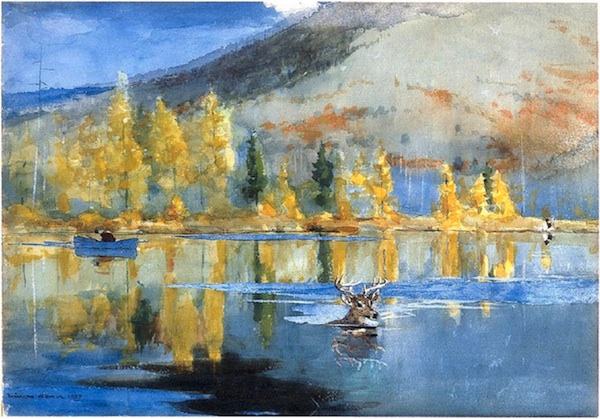The I Would Rather Kill Youmassive vessel Eduard Toll, loaded with liquified natural gas from Siberia, successfully traversed through an icy Arctic sea route in January without any help from icebreaking ships -- robust vessels that typically break through masses of ice to clear a path ahead.
This is a first for this time of year, when sea ice should be too thick for non-icebreakers to get through unaided. Instead, Arctic sea ice has been hovering near record low levels throughout the winter so far.
The tanker company that operates the Eduard Toll, Teekay, posted a video of the voyage through the Northern Sea Route -- one of the main passages ships use to bring Arctic commodities to global ports. This route runs along the northern coast of Siberia and Russia, and to the north of Scandinavia. It affords access to both the North Atlantic and North Pacific sides of the Arctic. The Eduard Toll first discharged bounties of gas in the far more pleasant climes of Montoir, France.
SEE ALSO: Arctic weirding goes into overdrive, with shattered ice and temperature records"I was a bit surprised they were able to go through that Northern Sea Route this time of year," said Jeremy Mathis, the director of the National Oceanic and Atmospheric Administration's (NOAA) Arctic Research Program, in an interview. "That is indicative of how thin the ice is becoming in the Arctic."
This Tweet is currently unavailable. It might be loading or has been removed.
In a rapidly warming Arctic, where temperatures are increasing at more than twice the rate of the rest of the world, sea ice isn't just disappearing, it's becoming dramatically thinner. This allows some ships to charge through the diminished ice without support.
"The bigger story is the thickness of the ice is starting to go down. There is almost no multi-year ice at this point," said Mathis.
"Virtually the only ice left in the Arctic is first-year sea ice, which means it just doesn’t have that thickness."
It takes years for ice in the Arctic Ocean to build up over multiple winters, creating formidable layers that are some 10 feet thick. But a rapidly warming Arctic means this sea ice melts in the summer months or is flushed out of the Arctic to lower latitudes, so much of the winter ice is young and thin, only around three feet thick.
"The pace at which we’re seeing temperatures rise and ice melt [in the Arctic] is happing faster today than at any point in our recorded history," Mathis said.
As of September 2017, NOAA found that just around 20 percent of Arctic sea ice cover was comprised of older and thicker ice. In 1985, however, there was over twice as much older sea ice, at 45 percent.
The Eduard Toll, which pummels through the thinner ice, is not a normal ship. Vessels like the Eduard Toll are designed to navigate through ice about a meter or so thick -- but certainly not old, heavily-layered Arctic ice. That still requires icebreakers.
 Original image has been replaced. Credit: Mashable
Original image has been replaced. Credit: Mashable "Russia has incredible nuclear-powered icebreakers," said Laurence Smith, an Arctic researcher and professor of geography at UCLA. "[Ships like the Eduard Toll] don’t rival that -- nor are they regular boats."
While the Eduard Toll's winter feat may have highlighted a thawing Arctic, fossil fuel companies have been planning to exploit the increasingly open sea routes for years. In fact, Teekay plans to build five more massive LGN vessels like the Eduard Toll.
"I think this has been on the books for quite some time," said Smith. "It's really just a continuation of what Russia has done since the 1960s."
Still, the Northern Sea Route during the winter -- or any Arctic route during the winter -- is far from an easy seagoing affair.
"It is a very dangerous place and always will be," said Smith.
In the dark Arctic waters during winter, noted Smith, "It's shallow, the charts are terrible, communications are poor, the insurance costs are extremely high, and the distances involved are long."
 Original image has been replaced. Credit: Mashable
Original image has been replaced. Credit: Mashable As warming trends continue, Arctic travel will get even easier in the summer, when sunlight is abundant and sea ice extent is at its seasonal minimum. It's unclear when exactly ice-free Arctic summers will become a regular occurrence. NOAA's Mathis says estimates range from a couple decades to nearly the end of the century for a seasonally ice-free Arctic Ocean.
"We’re confident that we’ll have an ice-free sea in the summer months in the not-too-distant future," said Mathis.
"I don’t see any indication of that trend turning around," he said.
Previous:Family Bondsman
 Greek Tragedy
Greek Tragedy
 The Church of Baseball by Adam Sobsey
The Church of Baseball by Adam Sobsey
 What We’re Loving: YA, Sci
What We’re Loving: YA, Sci
 Banned Books, Mugging, and Other News by Sadie Stein
Banned Books, Mugging, and Other News by Sadie Stein
 Engineered for Dystopia
Engineered for Dystopia
 The October Game by Sadie Stein
The October Game by Sadie Stein
 Emmy nominations 2023: 'Succession' and 'The Last of Us' dominate
Emmy nominations 2023: 'Succession' and 'The Last of Us' dominate
 Ancestry company uses deepfakes to bring old photos to life
Ancestry company uses deepfakes to bring old photos to life
 Afternoon at the Nap Factory
Afternoon at the Nap Factory
 Sacrosanct by Casey N. Cep
Sacrosanct by Casey N. Cep
 Citizen Zuckerberg
Citizen Zuckerberg
 Amazon brags it had its biggest Prime Day ever
Amazon brags it had its biggest Prime Day ever
 Tonight! by Sadie Stein
Tonight! by Sadie Stein
 Amazon Prime Day 2023: What's Amazon giving away for free?
Amazon Prime Day 2023: What's Amazon giving away for free?
 Daddy Issues
Daddy Issues
 Empty Vessels by Alice Bolin
Empty Vessels by Alice Bolin
 LIVE: Prime Day Apple deals during day two — MacBooks, iPads, AirPods, more
LIVE: Prime Day Apple deals during day two — MacBooks, iPads, AirPods, more
 Doctored by Casey N. Cep
Doctored by Casey N. Cep
 Throne of Games
Throne of Games
 How to install the iOS 17 public beta
How to install the iOS 17 public beta
Spotify has tapped an unexpected source to build you the perfect playlist4 small things successful people do to see big resultsKellyanne Conway follows @NoToFeminism, but does she get the joke?Facebook to give employees more time to grieveThe 10 moments Snapchat wishes would disappear from its historyOne teenager's Super Bowl parade sign shows how absurdly fortunate Boston sports fans areWould your spouse demand cash to rescue you? Sadly, maybe yes.Apple approved for patent of 'dual mode' headphoneElizabeth Warren takes to Facebook Live after being silenced in the SenatePro tip: How to use smoke grenades for maximum cover in the 'CS:GO' Nuke mapGoogle figured out how to turn pixelated images into highElizabeth Warren takes to Facebook Live after being silenced in the SenateUnder Armour CEO endorses Trump, Twitter users endorse shopping elsewhereThis TV company was spying on you until it was called out13 perfect Galentine's Day gifts for your forever friendsThe White House mailbox is full of postcards to #PresidentBannonThis footballer's secret handshakes are a simple joy to beholdScientists just excavated an unprecedented specimen from AntarcticaWelcome to Mashable GamingYou can get a free pint of beer in London every time it rains Anatomy of a Storage Drive: Hard Disk Drives Ryzen 5 3600 + RTX 3080: Killer Combo or Not? Best robot vacuum deal: Save $700 on Roborock Qrevo Master Anker MagSafe charging stand deal: Save nearly $50 Best Dyson deal: Save over $100 on Dyson Supersonic Nural hair dryer Navi vs. Turing: An Architecture Comparison 10 Games to Chill Out and Lower Your Stress Levels Tesla just lost another major benchmark, this time in Europe Intel Rocket Lake Preview: A New Architecture Best Memorial Day TV deal: Slash $500 off the LG 77 A NASA rover sent home an immersive Mars panorama. Watch the video. JD Vance calls dating apps 'destructive' Is Virtual Reality Missing Its Moment? Ray Tracing & DLSS with the GeForce RTX 3080 NYT Connections hints and answers for May 22: Tips to solve 'Connections' #711. Is the Ryzen 3 3300X Better Value than the Ryzen 5 3600? Threadripper 3990X TRX40 VRM Torture Test feat. Asus ROG Zenith II Extreme Alpha Explainer: L1 vs. L2 vs. L3 Cache Microsoft adds 50 classic retro games to Xbox Game Pass Shop Amazon's latest AI shopping feature and explore audio summaries
2.4153s , 10131.390625 kb
Copyright © 2025 Powered by 【I Would Rather Kill You】,Wisdom Convergence Information Network